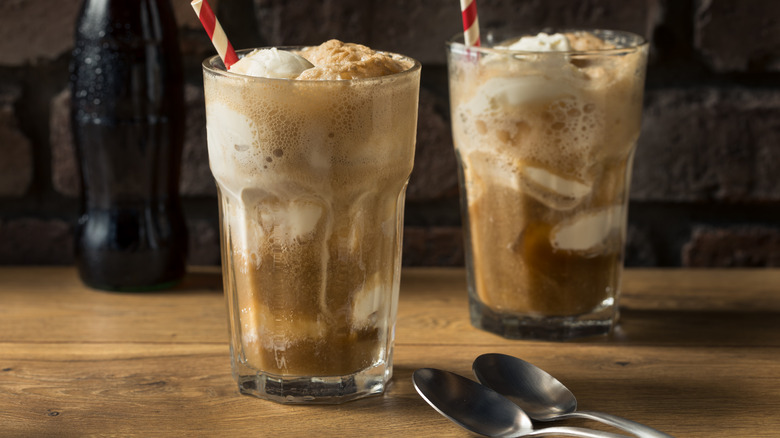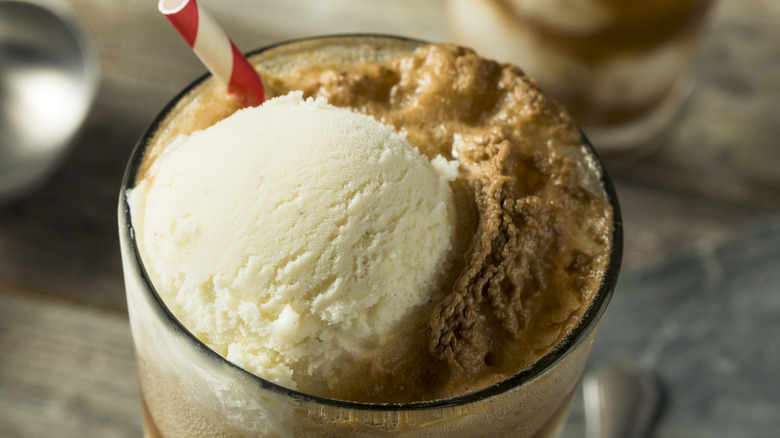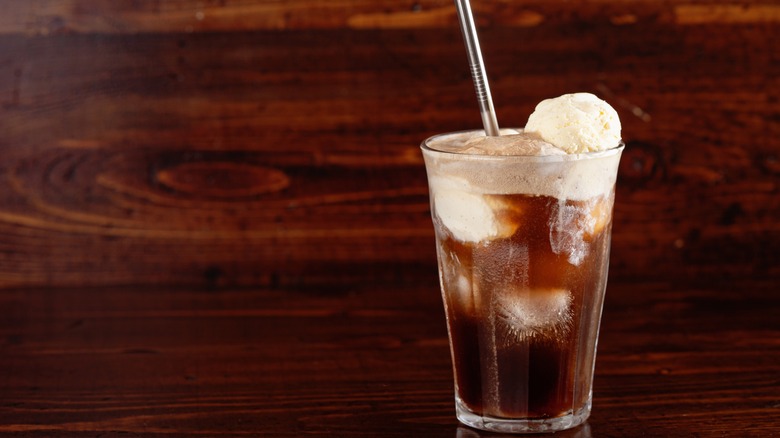The Spontaneous Invention Of The Ice Cream Float
What's your soda fountain treat of choice? These hangouts got their start in 1850s America when pharmacies and drugstores began offering cure-all tonics, which typically featured flavored medicinal extracts (and, very often, cocaine) mixed into soda water (via Pharmacy Times). Over time, soda fountains expanded their menus to include less curative options such as milkshakes, ice cream floats, and sundaes. In the 1950s, they became a popular and wholesome spot for teen gatherings and first dates (via Dusty Old Thing).
Other than the occasional novelty soda fountain, these old-fashioned spots have mostly faded away, but the icy offerings they once served remain popular choices at ice cream shops and diners. Take, for example, that beloved summer cooler, the ice cream float. Also known as an ice cream soda, that's exactly what the drink-dessert hybrid is, according to Food Network: A tall, cold glass of soda (either from a can or made at home by stirring syrup into seltzer), with some ice cream scooped in. A classic American treat, the ice cream float was born in Philadelphia in 1876 and has endured ever since.
Drug store clerk Robert M. Green invented the drink in a pinch
If you've ever sipped on an ice cream float, then you know how delicious the drink can be, with the scoop of ice cream taking on an icy outer shell and its creaminess contrasting with the bubbliness of the soda. Americans have loved this drink for more than 140 years, according to "The Soda Fountain," a now-defunct "Illustrated Monthly Publication for the Soda Fountain Trade" that was published in the early 1900s. A Google Books result for a January 1921 edition of the magazine explains the origin of the ice cream float, attributing it to drug store clerk Robert M. Green, who was tasked with manning the soda fountain installation at his employer's booth at the World's Fair held in Philadelphia in 1876.
According to the excerpt, Green had bought himself some ice cream from a neighboring stand as part of his lunch, when suddenly the idea occurred to him to place a spoonful into some of the soda he had been slinging at the drugstore's fountain. He tried out his creation on several customers, who loved it so much that the fountain became packed and Green found it challenging to buy enough ice cream for all the drinks.
Alternate versions of the story
Other sources, including the Chicago Tribune and the journal, "Pediatrics," relate a similar origin story, but say that the drink came about a bit differently. Both sources place the date as 1874, not at the World's Fair that the city hosted two years later, but at a smaller semi-centennial celebration of Philadelphia's Franklin Institute science and technology museum. Green, who was vending drinks that were a mixture of soda water, sweet cream, and syrup (much like a New England-style milkshake), ran out of cream and began substituting vanilla ice cream in the drink. As the story goes, customers began flocking to the stand for the new invention, and Green, who had been taking in $6 per day for the soda water drink, sold upwards of $600 per day in ice cream floats toward the end of the event.
Whatever the true origins of the drink, "Pediatrics" relates that once-drug-store-clerk Green went on to earn a fortune as a soda manufacturer. By 1893, according to the Chicago Tribune, his ice cream float invention was popular across the U.S., and named the country's national beverage by a "leading magazine." In 1920, when he died, Green's will included provisions for his headstone in a Philadelphia cemetery to be inscribed: "Here lies the originator of the ice cream soda."


